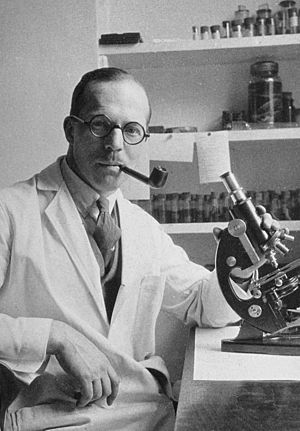Cecil Hoare facts for kids
Quick facts for kids
Cecil Hoare
|
|
|---|---|

Cecil Arthur Hoare c. 1930
|
|
| Born | 6 March 1892 Middelburg, Netherlands
|
| Died | 23 August 1984 (aged 92) |
| Nationality | British |
| Alma mater | Saint Petersburg State University, Russia |
| Spouse(s) |
|
| Awards | Manson Medal (1974) |
| Scientific career | |
| Fields | Protozoology, parasitology |
Cecil Arthur Hoare (born March 6, 1892 – died August 23, 1984) was a British scientist. He was a protozoologist, which means he studied tiny, one-celled living things called protozoa. He was also a parasitologist, meaning he studied parasites. Parasites are organisms that live on or in another organism and get their food from it.
Contents
Discovering Life: Early Years and Education
Cecil Hoare was born in Middelburg, a town in the Netherlands, on March 6, 1892. His mother, Luboff Shalyte, was from Russia.
When Cecil was about six years old, his mother took him and his older sister, Catherine, to Russia. There, Cecil started school in the Gymnasium system.
Later, in 1912, when he was 20, Cecil began studying at Saint Petersburg State University in Russia. He chose to specialize in zoology, which is the study of animals. He finished his studies and graduated in 1917.
Cecil had a medical condition called chronic otitis media, which caused deafness in one ear since he was a child. Because of this, he was not required to join the military.
A Scientist's Journey: Hoare's Career
Soon after graduating, Cecil Hoare became a Research Fellow at the University of Petrograd (now Saint Petersburg). He worked closely with Professor Valentin Dogiel, a well-known zoologist.
In 1920, Hoare moved from Russia to England. He quickly found a job at the National Institute for Medical Research. Here, he started publishing many scientific papers about his research.
In 1923, he joined the Wellcome Bureau of Scientific Research in London. He was appointed as a protozoologist. Later, he became the Head of the Department of Protozoology. He held this important position for 34 years, until he retired in 1957.
Studying Parasites in Uganda
In 1927, Hoare went to Entebbe, Uganda, for two years. He worked with the Uganda Medical Service. His main task was to investigate the life cycle of crocodile trypanosomes. Trypanosomes are tiny parasites that can cause diseases in animals and humans. He specifically studied Trypanosoma grayi, which affects crocodiles.
After World War II, Hoare continued to publish many scientific papers. He also traveled a lot to support his research and work with other scientists around the world. He visited the United States in 1948, Lisbon, Portugal, in 1958, and the Soviet Union in 1959. Because he spoke Russian, he received a very warm welcome there.
Recognized Achievements: Awards and Honours
Cecil Hoare was a highly respected scientist. On March 16, 1950, he was made a Fellow of the Royal Society. This is a very high honour for scientists in the United Kingdom.
Life Beyond the Lab: Personal Life
In 1915, Cecil Hoare married Alexandra Marti. She was a professional pianist and taught music in Russia.
After the Russian Revolution in 1917, Cecil left Russia in 1920 and moved to England. His mother and sister Catherine also joined him there. He settled in Chiswick, London, where he would live for most of his life.
Later, around 1930, Hoare met Marie Leserson. She became his second wife in 1954. They lived together in Chiswick.
Cecil Hoare's younger sister, Lilian, was sadly killed during the London Blitz on September 18, 1940. This happened due to enemy action during World War II.

